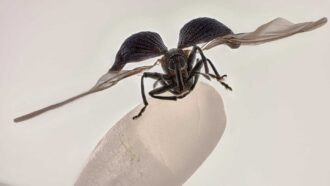Walks on the wild side
Animals that roam widely in the wild do more poorly in zoos than those with smaller ranges.
Share this:
- Share via email (Opens in new window) Email
- Click to share on Facebook (Opens in new window) Facebook
- Click to share on X (Opens in new window) X
- Click to share on Pinterest (Opens in new window) Pinterest
- Click to share on Reddit (Opens in new window) Reddit
- Share to Google Classroom (Opens in new window) Google Classroom
- Click to print (Opens in new window) Print
By Emily Sohn
There are people who love zoos, and there are people who hate them.
Apparently, the same goes for animals.
After a 3-year review of studies of animal behavior at 40 zoos, two researchers from England have concluded that animals needing lots of space in the wild often do horribly in zoos. Their babies tend to die at higher rates. And they are more likely to pace back and forth, a behavior that signals boredom or distress.
 |
|
Wide-ranging animals, such as polar bears, may be especially prone to trouble in zoos, while animals with smaller ranges adapt more easily.
|
The researchers looked at 35 meat-eating animals, including lions, cheetahs, brown and black bears, mink, brown hyenas, and arctic foxes. Results showed that animals that cover the most ground when they’re allowed to roam free are the ones that suffer the most in zoos.
Polar bears, for example, often develop severe pacing habits in captivity, possibly because they feel so cramped. In the wild, polar bears range over at least 1,200 square kilometers every year. In zoos, they get about a millionth as much space. Arctic foxes, on the other hand, usually cover less than a square kilometer in the wild, and they seem to deal with zoo life just fine.
Researchers aren’t quite sure what to make of the somewhat controversial findings. Animals that have large home ranges are often among the most threatened species. Now, it could be even harder to protect them in captivity. Zoos might have to come up with better exhibit designs that give animals enough space to feel like they’re at home.







